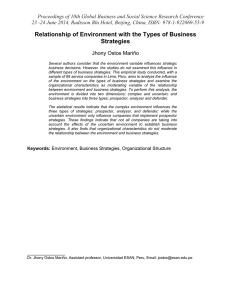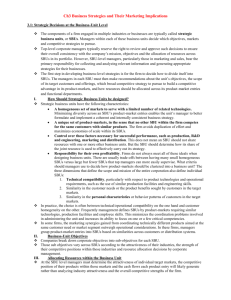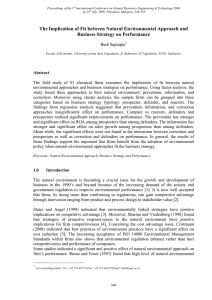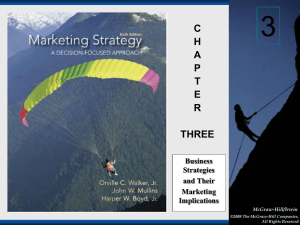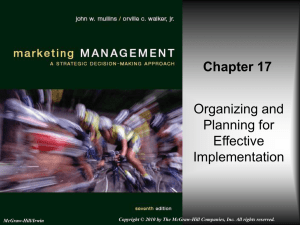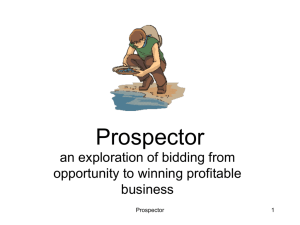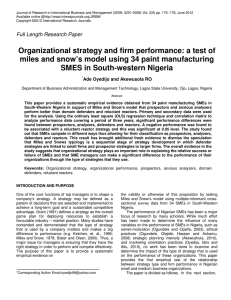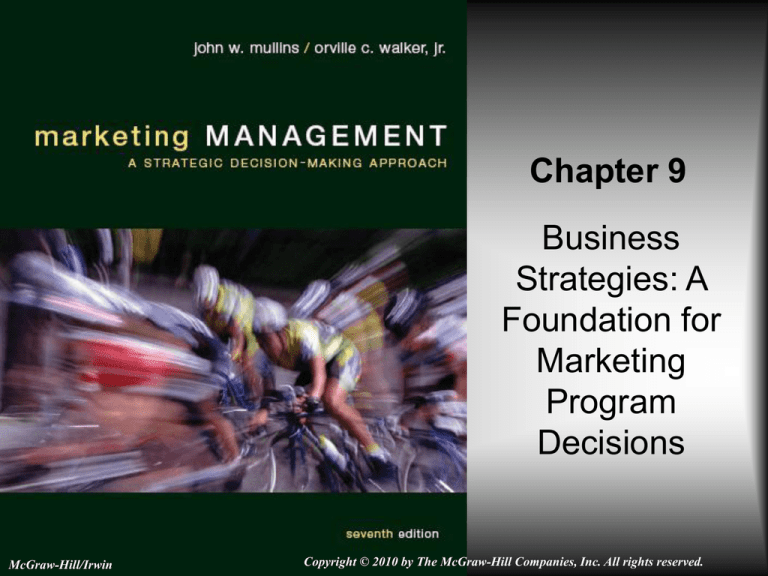
Chapter 9
Business
Strategies: A
Foundation for
Marketing
Program
Decisions
McGraw-Hill/Irwin
Copyright © 2010 by The McGraw-Hill Companies, Inc. All rights reserved.
How Do Businesses Compete?
•
•
Business strategies are primarily
concerned with allocating resources
across functional activities and productmarkets to give the unit a sustainable
advantage over its competitors.
The unit’s core competencies and
resources, together with the customer
and competitive characteristics of its
industry, determine the viability of any
particular competitive strategy.
9-2
How Do Businesses Compete?
•
Generic business-level competitive
strategies
–
Strategies to gain and maintain competitive
advantages (Michael Porter):
•
•
•
Overall cost leadership
Differentiation
Focus
9-3
How Do Businesses Compete?
– Strategies based on intended rate of
product-market development (Robert Miles
and Charles Snow):
•
•
•
•
Prospectors focus on growth through the
development of new products and markets.
Defenders concentrate on maintaining their
positions in established product-markets while
paying less attention to new product
development.
Analyzers try to maintain a strong position in
core product-market(s) but seek expansion into
new product-markets.
Reactors have no clearly defined strategy.
9-4
Combined Typology of Business-Level Competitive
Strategies
9-5
How Do Businesses Compete?
– The combined typology describes six
business strategies, and each of the
strategic categories could be further
subdivided.
– It classifies business strategies on two
primary dimensions:
•
•
The unit’s desired rate of product-market
development (expansion).
The unit’s intended method of competing in its
established product-markets.
9-6
How Do Businesses Compete?
•
Do the same competitive strategies work
for single-business firms and start-ups?
– The same set of generic strategies are just
as appropriate for small firms as for
business units within larger ones.
– In reality most entrepreneurial firms begin
life as prospectors.
9-7
How Do Businesses Compete?
•
Do the same competitive strategies work
for service businesses?
– Basically, services can be thought of as
intangibles and goods as tangibles.
– The former can rarely be experienced in
advance of the sale, while the latter can be.
– The framework used to classify businesslevel competitive strategies is equally valid
for service businesses.
9-8
How Do Businesses Compete?
•
Do the same competitive strategies work
for global competitors?
– Businesses that compete in multiple global
markets almost always pursue one of the
two types of analyzer strategy.
– A single SBU may need to engage in
different functional activities across the
various countries in which it competes.
9-9
How Do Businesses Compete?
•
Will the Internet change everything?
– It will be harder for firms to differentiate
themselves on any basis other than low
price.
– Strategies focused on differentiation will
become less viable, while firms pursuing
low-cost strategies will be more successful.
9-10
How Do Businesses Compete?
– The Internet is primarily a communications
channel.
•
While it facilitates the dissemination of
information, the goods and services themselves
will continue to offer different features and
benefits.
– The Internet will make it easier for firms to
customize their offerings and personalize
their relationships with their customers.
9-11
How Do Competitive Strategies Differ
from One Another?
•
Differences in scope
– The breadth and stability of a business’s
domain are likely to vary with strategies.
– This can affect the variables the corporation
uses to define its various businesses.
– Defender businesses tend to operate in
relatively well-defined, narrow, and stable
domains where both the product technology
and the customer segments are mature.
9-12
How Do Competitive Strategies Differ
from One Another?
– Prospector businesses usually operate in
broad and rapidly changing domains where
neither the technology nor customer
segments are well established.
– Analyzer businesses usually have a wellestablished core business to defend, and
often their domain is primarily focused on
that business.
9-13
How Do Competitive Strategies Differ
from One Another?
•
Differences in goals and objectives –
Important performance dimensions:
–
–
–
Effectiveness—the success of a business’s
products and programs relative to those of
its competitors in the market.
Efficiency—the outcomes of a business’s
programs relative to the resources used in
implementing them.
Adaptability—the business’s success in
responding over time to changing conditions
and opportunities in the environment.
9-14
How Do Competitive Strategies Differ
from One Another?
– It is very difficult for any SBU, regardless of
its competitive strategy, to simultaneously
achieve outstanding performance on even
this limited number of dimensions.
9-15
How Do Competitive Strategies Differ
from One Another?
•
Differences in resource deployments
– Prospector—and to a lesser degree,
analyzer—businesses devote a relatively
large proportion of resources to the
development of new product-markets.
– Defenders focus the bulk of their resources
on preserving existing positions in
established product-markets.
– Resource allocations among functional
departments and activities within the SBU
also vary across businesses pursuing
different strategies.
9-16
How Do Competitive Strategies Differ
from One Another?
•
Differences in sources of synergy
– The sharing of operating facilities and
programs may be an inappropriate approach
to gaining synergy for businesses following
a prospector strategy.
– Low-cost defenders should seek operating
synergies that will make them more efficient.
9-17
Deciding When A Strategy is
Appropriate
•
Prospector strategy
– Suited to unstable, rapidly changing
environments resulting from new technology,
shifting customer needs, or both.
– Most successful prospectors are usually
strong in two broad areas of competence:
•
•
R&D, product engineering, design, and other
functional areas that identify new technology and
convert it into innovative products
Marketing research, marketing and sales.
9-18
Deciding When A Strategy is
Appropriate
•
Analyzer strategy
– Appropriate for well-developed industries
that are still experiencing some growth and
change.
– Analyzers are often not as innovative in new
product development as prospectors.
9-19
Deciding When A Strategy is
Appropriate
•
Defender strategy
– Appropriate for units with a profitable share
of one or more major segments in a
relatively mature, stable industry.
– It works best in industries where:
•
•
The basic technology is not very complex.
It is well developed and unlikely to change
dramatically over the short term.
9-20
Deciding When A Strategy is
Appropriate
–
Differentiated defenders
•
•
–
A business must be strong in those functional
areas critical for maintaining its particular
competitive advantages over time.
Marketing is also important
Low-cost defenders
•
•
Requires the business to be more efficient than
its competitors.
Efficiency and low price are the primary focus.
9-21
How Different Business Strategies
Influence Marketing Decisions
•
Product policies
– These concern the breadth or diversity of
product lines, their level of technical
sophistication, and the target level of
product quality relative to competitors.
– For prospector businesses, policies
encouraging broader and more technically
advanced product lines than those of
competitors should be positively related to
performance.
9-22
How Different Business Strategies
Influence Marketing Decisions
•
Product policies (cont.)
– Differentiated defenders compete by offering
more or better choices to customers than do
their competitors.
– Broad and sophisticated product lines are
less consistent with the efficiency
requirements of the low-cost defender
strategy.
– Businesses can distinguish themselves on
the quality of service they offer.
9-23
How Different Business Strategies
Influence Marketing Decisions
•
Pricing policies
– Success in offering low prices relative to
those of competitors should be positively
related to the performance of low-cost
defender businesses.
– Differentiated defenders and prospectors
seldom adhere to a policy of low competitive
prices.
9-24
How Different Business Strategies
Influence Marketing Decisions
•
Distribution policies
– A relatively high degree of forward vertical
integration is found among defender
businesses, particularly differentiated
defenders.
– Prospectors rely more heavily on
independent channel members to distribute
their products.
9-25
How Different Business Strategies
Influence Marketing Decisions
•
Promotion policies
– High advertising and sales promotion
expenditures are likely to bear a positive
relationship to the new product and sharegrowth success of prospector businesses.
– Differentiated defenders are primarily
concerned with maintaining the loyalty of
established customers by adapting to their
needs and providing good service.
9-26
How Different Business Strategies
Influence Marketing Decisions
•
Promotion policies (cont.)
– Low-cost defenders businesses are likely to
make relatively low expenditures as a
percentage of sales on promotional
activities.
9-27
What If the Best Marketing Program for a Product
Does Not Fit the Business’s Competitive Strategy?
•
Effective implementation of different
business strategies requires:
– Different functional competencies and
resources.
– Different organizational structures, decisionmaking and coordination processes, reward
systems, and even personnel.
9-28
What If the Best Marketing Program for a Product
Does Not Fit the Business’s Competitive Strategy?
•
In view of the implementation problems
involved, some firms might form new
prospector SBUs to pursue emerging
technologies and industries rather than
expecting established units to handle
extensive new product development
efforts.
9-29
What If the Best Marketing Program for a Product
Does Not Fit the Business’s Competitive Strategy?
•
As individual product-market entries gain
successful positions in growing markets,
some firms move them from the
prospector unit that developed them into
an existing analyzer or defender unit, or
even into a newly formed SBU.
9-30
What If the Best Marketing Program for a Product
Does Not Fit the Business’s Competitive Strategy?
•
Some firms that are technological
leaders in their industries may divest or
license individual product-market entries
as they mature rather than defend them
in the face of increasing competition and
eroding margins.
9-31
Take-Aways
•
Research suggests that a business is
likely to achieve superior revenue
growth, market share, and profitability
when there is a good fit between its
competitive strategy and the strategic
marketing programs of its various
product or service offerings.
9-32
Take-Aways
•
Business-level competitive strategies
can be usefully categorized into:
– Prospector strategies focused on growth
via the development of new products and
markets;
– Defender strategies primarily concerned
with defending strong positions in
established markets; and
– Analyzer strategies, which are hybrids of
the other two strategies.
9-33
Take-Aways
•
The generic competitive strategies
described in the previous point apply
equally well to services and physical
products, single-product start-ups and
multidivisional corporations, and global
and domestic operations, and they are
unlikely to change dramatically due to
the rise of e-commerce.
9-34
Take-Aways
•
Because the various business-level
strategies focus on different objectives
and seek to gain a competitive
advantage in different ways, marketing
may play a different role under each of
the strategies, and varying marketing
actions may be called for.
9-35
Take-Aways
•
The marketing decision maker’s job is to
develop a sound, evidence-based marketing
strategy for his or her offering and to make a
persuasive case for its support.
–
If that strategy does not fit the objectives or
available resources and competencies of the
business unit in which the product is housed, top
management may choose to move the product
to a more amenable unit or require adjustments
to the strategy.
9-36


